FY2019 Annual Report
Quantum Dynamics Unit
Professor Denis Konstantinov
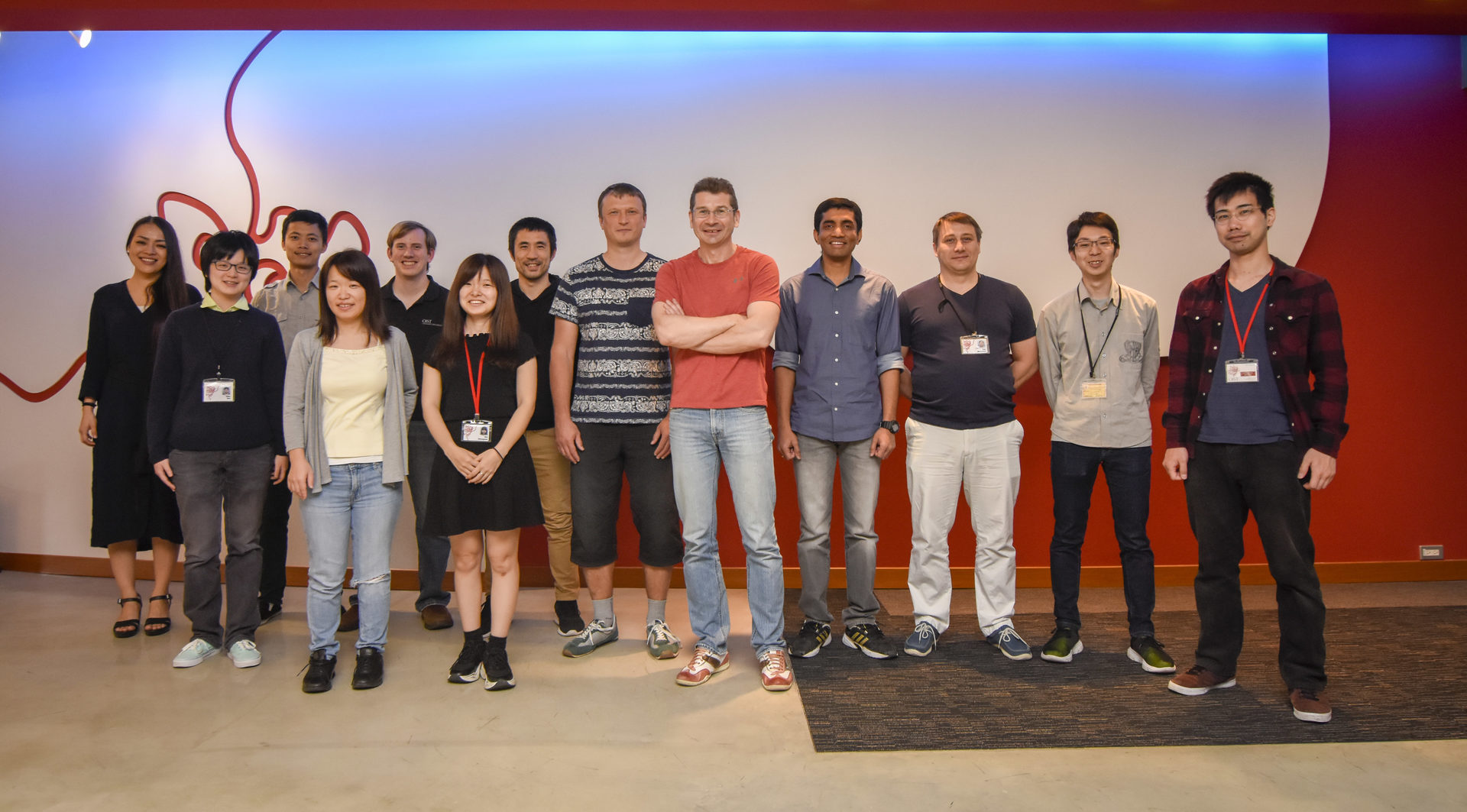
Left to right: Yoko Fujitomi (Research Administrator), Shan Zou, Jiabao Chen, Erika Kawakami , Jason Ball, Reo Shinagawa, Yui Kubo, Oleksiy Zadorozhko, Denis Konstantinov, Emil Joseph, Peter Moroshkin, Morihiro Ohto, Shota Norimoto
Abstract
In FY2019, we employed our new method, the image-charge detection, to study excitation dynamics of quantum Rydberg states in electrons on helium. This became possible due to our recent developments in the cryogenic amplification circuits. We also started developing another new method based on the heterodyne detection of optical absorption, which has potential to study dynamics of quantum states of electrons on helium in a nano-second time scale. We carried out other experiments with electrons on helium, in particular in tilted quantizing magnetic fields (Jiabao Chen, PhD 2019), as well as experiments with coupled electron-nuclear spin ensembles in solid-state antiferromagnets and impurity spins in diamond.
1. Staff
- Dr. Yuimaru Kubo, Staff Scientist/Group Leader
- Dr. Petr Moroshikin, Staff Scientist
- Dr. Erika Kawakami, Postdoc Scholar
- Dr. Oleksiy Zadorozhko, Postdoc Scholar
- Dr. Asem Elarabi, Postdoc Scholar
- Dr. Emil Joseph, Postdoc Scholar (Kakenhi)
- Dr. Shota Norimoto, Postdoc Scholar (POC)
- Jason Ball, PhD Student (OIST)
- Jiabao Chen, PhD Student (OIST)
- Zou Shan, PhD Student (OIST)
- Morihiro Ohta, Part-time Research Assistant (POC)
- Reo Shinagawa, Part-time Research Assistant
- Yoshihito Tamashiro, Part-time Research Assistant
- Ryoko Miyahira, Research Assistant (POC)
- Tomoe Furuya, Research Unit Administrator (Temporary)
- Taki Tazuke, Research Unit Administrator
2. Collaborations
2.1 Nonlinear NMR in coupled electron-nuclear spin ensembles
- Description: Peculiarities of coupled electron-nuclear spin precession in a magnon Bose-Einstein condensate in MnCO3 antiferromagnet
- Type of collaboration: Joint research
- Researchers:
- Dr. Yuriy Bunkov, Russian Quantum Center, Skolkovo, Russia
2.2 Electrons on helium in a tilted quantizing magnetic field
- Description: Phenomena associated with coupling between orbital motional states of electrons on helium induced by the tilted magnetic field.
- Type of collaboration: Joint research
- Researchers:
- Dr. Alexey Chepelianskii, Laboratoire Physics Solidity, University Paris-Sud, France
2.3 Cryogenic circuits for experiments with electrons on helium
- Description: Development of a cryogenic tunnel-diode generator for detection of Rydberg-state excitation in electrons on helium.
- Type of collaboration: Joint research
- Researchers:
- Dr. Olexiy Rybalko, Verkin Institute for Engineering and Low-Temperature Physics, Ukraine
2.4 Nanofabrication of a device to trap a single electron on helium
- Description: Nanofabrication of a device to trap a single electron on helium
- Type of collaboration: Joint research
- Researchers:
- Dr. Yury Mukharsky, Nanoelectronics Group, SPEC, CEA-Saclay, France
2.5 Josephson parametric amplifier
- Description: Fabrication of Josephson parametric amplifiers
- Type of collaboration: Joint research
- Researchers:
- Denis Vion, Quantronics Group, SPEC, CEA-Saclay, France
3. Activities and Findings
3.1 Coupled quantum states of electrons on helium in tilted magnetic fields (O. Zadorozhko, J. Chen, in collaboration with A. Chepelianskii, Univ. Paris-Sud)
The Jaynes-Cummings model (JCM) describes an interaction between a two-level atom and quantum harmonic oscillator of an electromagnetic cavity mode. It is one of the fundamental models used in the Cavity Electrodynamics (CQED). Recently it was demonstrated (link) that an analogy of JCM can be realized using the orbital states of electrons on liquid helium in a tilted magnetic field. In this case, the surface-bound (Rydberg) states of an electron are coupled to the Landau levels of the electron cyclotron motion by the in-plane magnetic field. We carried out experiments to study coupled states by using the Stark spectroscopy method. In particular, we observed an avoided crossing between different energy eigenstates of electrons induced by the coupling, see Fig. 1 (left).
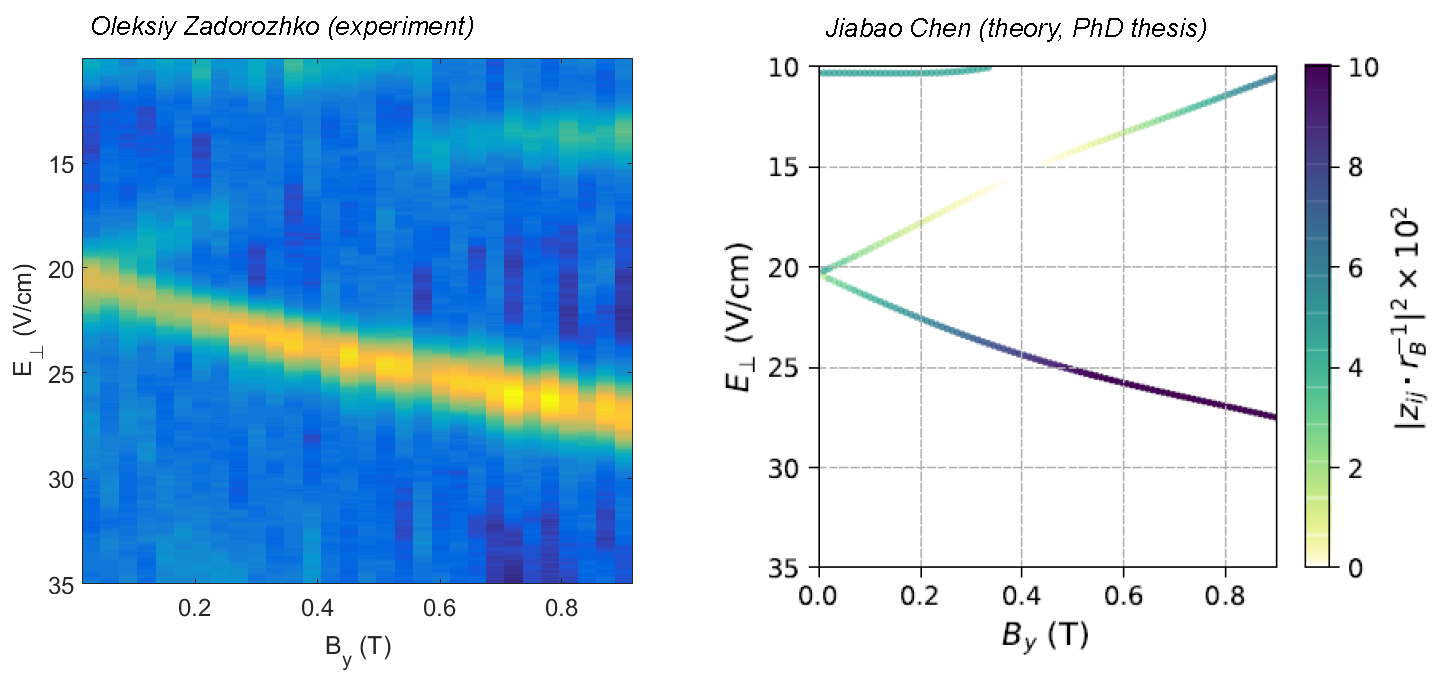
Figure 1: Vacuum Rabi splitting (left: experiment and right: calculation) between the first (n=2) excited and second (n=3) excited Rydberg states in 2D electrons on helium due to the coupling induced by the parallel component of magnetic field By.
This is an analogy of the vacuum Rabi splitting between coupled light-matter states in JCM. We show that our theoretical calculations of the coupled states, see Fig. 1 (right) are in excellent agreement with the experimental results. We hope that the strong non-linearity introduced to the coupled orbital motion of electrons will allow us to setup CQED-type of experiments with electron ensembles strongly coupled to a single-mode optical cavity.
3.2 Relaxation of the excited Rydberg states of electrons on helium probed by the image-charge detection method (E. Kawakami, A. Elarabi)
We employed our newly developed method of the image-charge detection (link) to study excitation and relaxation dynamics of the quantum Rydberg states of electrons on helium. In order to observe the real-time population of the excited Rydberg states, we employed a two-stage cryogenic amplification of the image charge in the bandwidth ~10 MHz, see Fig. 2.
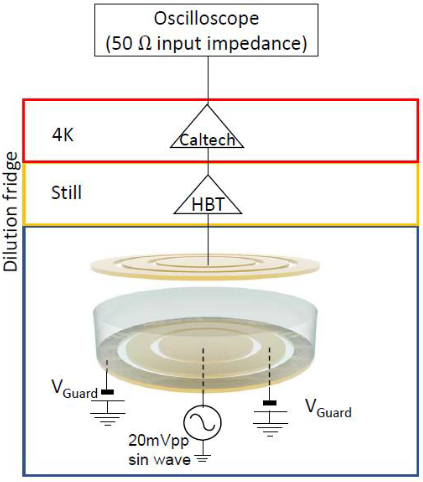
Figure 2: Schematic diagram of the real-time image current detection employing cryogenic two-stage amplification.
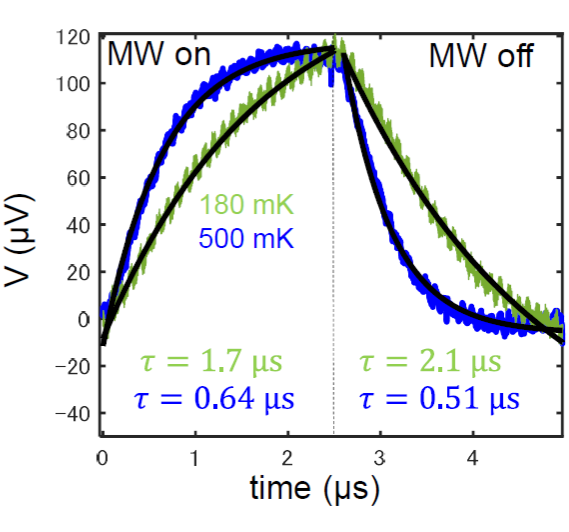
Figure 3: Real-time image-charge response of the electron system to pulsed (0<t<2.5 usec) resonant microwave excitation from the ground (n=1) to the first excited (n=2) Rydberg state.
This setup allowed us to observe, for the first time, the real-time excitation and relaxation dynamics of electrons due to pulsed microwave excitation, see Fig. 3. Now, we can make a number of important conclusions regarding the relevant time-scale of excitation and relaxation processes in this system. In particular, we find the relaxation time of the excited states at low temperatures due to the inelastic two-ripplon emission process to be of the order 1 usec. We hope this result will allow us to settle down a long-time controversy regarding the theoretical treatment of the inelastic processes in this system, which are important for realizing qubits with electrons on helium.
3.3 Excitation of quantum Rydberg states in electrons on helium by Rapid Adiabatic Passage (O. Zadorozhko)
The conventional optical absorption measurements in electrons on helium, which operate in millimeter-wave frequency range, employ the Putley (InSb) bolometers, therefore suffer from rather low bandwidth <1 MHz. Our newly developed image-charge detection technique can be pushed to a wider bandwidth (currently ~10 MHz) by properly designing the cryogenic part of the detection circuit. Yet, for some applications significantly larger bandwidth is required. We employed the heterodyne detection technique to measure optical transmission through the electron system, see Fig. 4. In the heart of this scheme is a home-made cryogenic microwave mixer based on the Schottky diode. Due to a very fast response time of the Schottky diode (nsec time scale) we were able to perform the microwave absorption detection within a very short intervals, see Fig. 5.
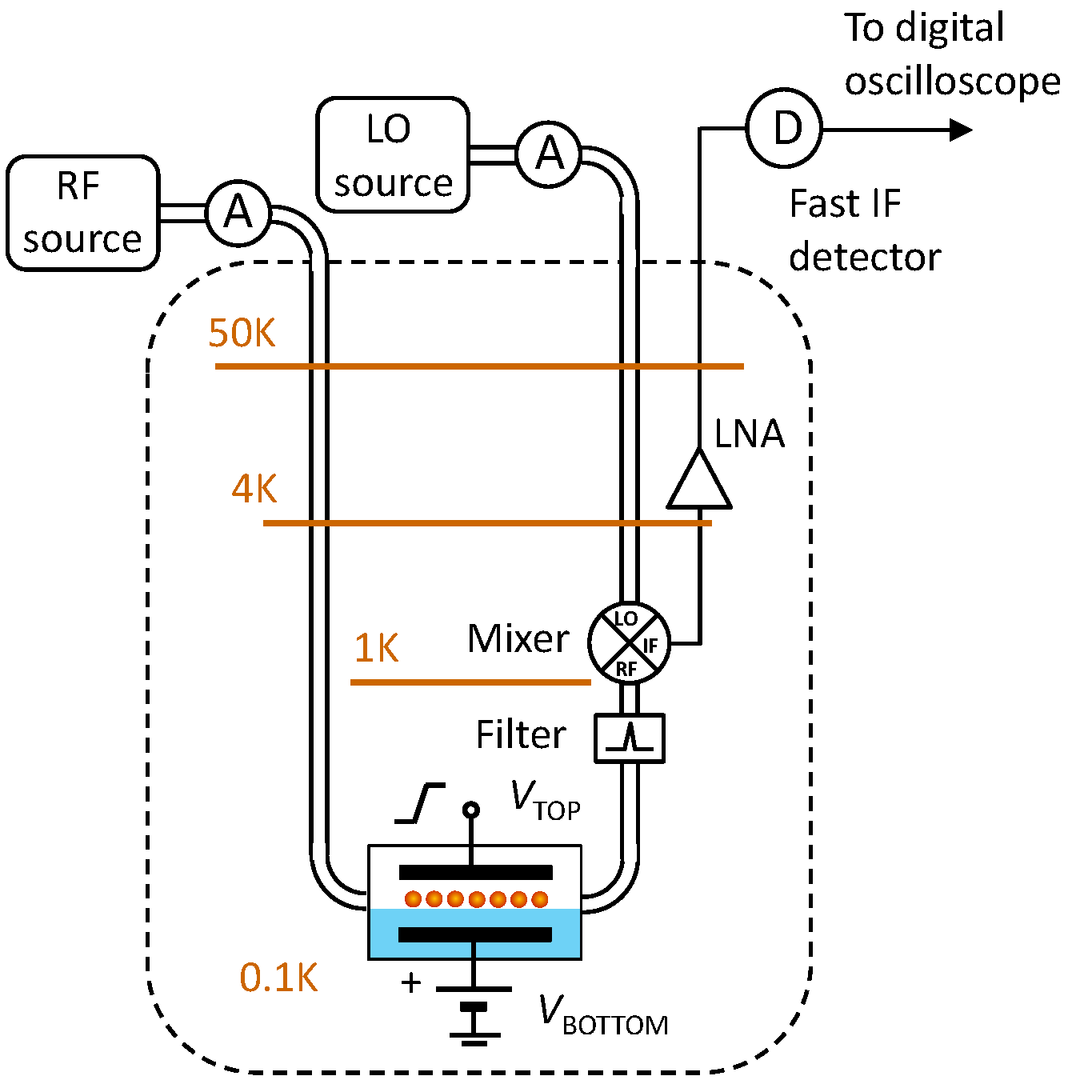
Figure 4: Schematic diagram of the heterodyne detection schema for optical absorption measurements in electrons on helium.
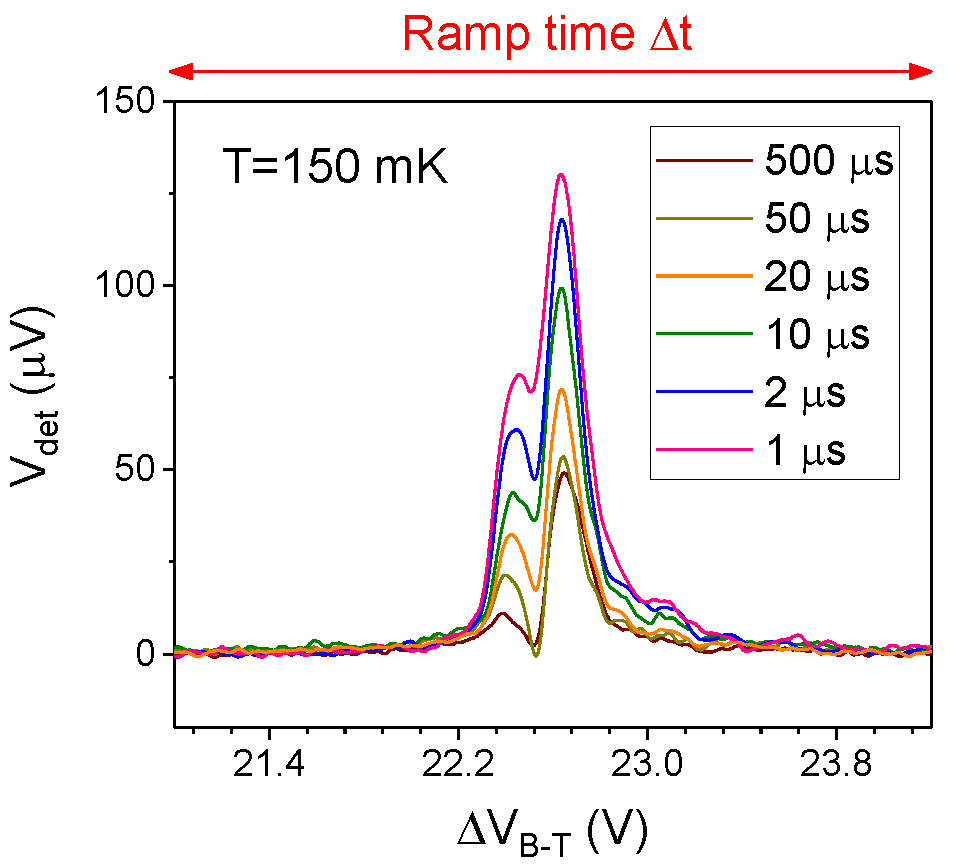
Figure 5: Real-time optical absorption signals obtained by fast (see time scale in the inset) Stark-ramps through the resonance.
In the experiment, we employed fast passages through the resonant transition between the ground (n=1) state and the first-excited (n=2) Rydberg state using the Stark effect. We observed a significant enhancement of the optical absorption signal by decreasing the passage time below 50 usec (see Fig. 5). This is the signature of the so-called Rapid Adiabatic Passage (RAP) through the coupled light-matter quantum state. This technique can have very interesting practical applications, in particular for quantum bits using electrons on helium.
3.4 Peculiarities of coupled electron-nuclear spin precession in the Bose-Einstein condensate of magnons in crystalline MnCO3 antiferromagnet (in collaboration with Y. Bunkov, Russian Quantum Center)
The strongly nonlinear NMR of coupled electron-nuclear spin systems observed in a number of solid-state antiferromagnets (MnCO3, CsMnF3, RbMnF3) is conventionally attributed to the heating of the paramagnetic nuclear spin system by the RF excitation and treated in the framework of the phenomenological Bloch equations. Recently we argued (link) that, instead, such systems must be described by the Landau-Lifshitz-Gilbert equations, which preserve the magnitude of the nuclear magnetization vector. We also argued that this can be interpreted as the Bose-Einstein condensation (BEC) of nonequilibrium nuclear magnons pumped by the RF excitation.
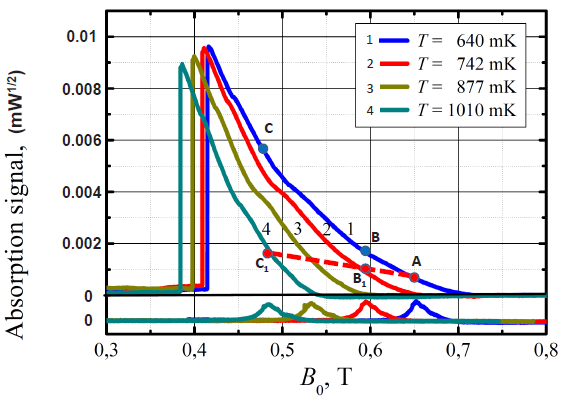
Figure 6: Nonlinear NMR absorption signals measured in crystalline antiferromagnet MnCO3 at different lattice temperatures T. At T=640 mK, if the nuclear spin system were described by the heating scenario, the absorption signal would follow the dashed line (A1-B1-C1) with decreasing magnetic field B0. Instead, it follows the blue line (A-B-C), which is consistent with our magnon BEC scenario.
In a new experiment, we studied the temperature dependence of the nonlinear NMR signals (both absorption and dispersion) in a weakly anisotropic easy-plane antiferromagnet MnCO3, see Fig. 6. By analyzing behaviour of the NMR signals with varying external magnetic field at different temperatures of the lattice T, we concluded that the heating scenario is inconsistent with the observed bahaviour. This provides further strong evidence for the appearance of magnon BEC in such systems.
4. Publications
4.1 Journals
-
A. O. Badrutdinov, D. G. Rees, J. Y. Lin, A. V. Smorodin, D. Konstantinov, "Unidircetional charge transport via ripplonic polarons in a athree-terminal microchannel device", Phys. Rev. Lett. 124, 126803, https://doi.org/10.1103/PhysRevLett.124.126803 (2020)
-
E. Kawakami, A. Elarabi, D. Kostantinov, "Image-Charge Detection of Rydberg States of Surface Electrons on Liquid Helium", Phys. Rev. Lett. 123, 086801, https://doi.org/10.1103/PhysRevLett.123.086801 (2019)
-
J. P. G. van Dijk, E. Kawakami, R. N. Schouten, M. Veldhorst, L. M. K. Vandersypen, M. Babaie, E. Charbon, F. Sebastiano, "Impact of classical control electronics on qubit fidelity", Phys. Rev. Applied 12, 04454 https://doi.org/10.1103/PhysRevApplied.12.044054 (2019)
-
Yu. P. Monarkha, D. Konstantinov, "Magneto-oscillations and anomalous current states in a photo-excited electron gas on liquid helium (Review Article)", J. Low Temp. Phys. 197, 208 https://doi.org/10.1007/s10909=019-02210-w (2019)
-
P. Moroshkin, P. Leiderer, Th. B. Moller, K. Kono, "Trapping of metallic nanoparticles under the free surface of superfluid helium in a static electric field", Phys. Fluids 31, 077104, https://doi.org/10.1063/1.5110530 (2019)
-
K. M. Yunusova, D. Konstantinov, H. Bouchiate, A. D. Chepelianskii, "Coupling between Rydberg States and Landau Levels of Electrons Trapped on Liquid Helium", Phys. Rev. Lett. 122, 176802, https://doi.org/10.1103/PhysRevLett.122.176802 (2019)
-
P. Moroshkin, P. Leiderer, K, Kono, S. Inui, M. Tsubota, "Dynamics of the Vortex-Particle Complexes Bound to the Free Surface of Superfluid Helium", Phys. Rev. Lett. 122, 174502, https://doi.org/10.1103/PhysRevLett.122.174502 (2019)
4.2 Books and other one-time publications
Nothing to report
4.3 Oral and Poster Presentations
-
Erika Kawakami, "Dispersive read-out of qubit states: towards realizing spin qubits using electrons on helium", oral presentation at The Annual Meeting of the Americal Physical Society, Denver, USA, Mar 2-6 (2020) (canceled due to COVID-9).
-
Shota Norimoto, "Development of wide-band ESR measurement at millikelvin temperature", poster presentation at The Physical Society of Japan 2020, Nagoya, Japan, Mar 17 (2020).
-
Yuimaru Kubo, "Quantum information technologies with maser," invited talks at the International Workshop for Young Researchers on the Future of Quantum Science and Technology(FQST2020), Tokyo, Japan, February 3-6 (2020).
-
Denis Konstantinov, "Microwave excitation of Rydberg states of electrons on helium by rapid adiabatic passage " invited talk at the EIH-2020, Bangalore, India, Jan 24-25 (2020).
-
Peter Moroshkin, "Dynamics of vortex-particle complexes bound to free surface of superfluid helium", invited talk at the EIH-2020, Bangalore, India, Jan 24-25 (2020).
-
Emil Joseph, "Co-planar Waveguides for detecting electrons on liquid helium" poster presentation at the EIH-2020, Bangalore, India, Jan 24-25 (2020).
-
Sebastian Grossenbach, "Detection of Rydberg states of electrons on helium confined in micro-channels", poster presentation at the EIH-2020, Bangalore, India, Jan 24-25 (2020).
-
Asem Elarabi, "Image-charge spectroscopy of the Rydberg states of surface electrons on liquid helium", invited talk at the EIH-2020, Bangalore, India, Jan 24-25 (2020).
-
Jason Ball, "Coupling an inverted spin ensemble to a microwave resonator", oral presentation at International Symposium on Hybrid Quantum Systems 2019, Matsue, Japan, Dec 1 (2019).
-
Petr Moroshkin, "Thermal maser in diamond", poster presentation at International Symposium on Hybrid Quantum Systems 2019, Matsue, Japan, Dec 1 (2019).
-
Jason Ball, "Coupling an inverted spin ensemble to a microwave resonator", oral presentation at Impurity Spins for Quantum Information & Technologies 2019, Safed, Israel, Sep 9 (2019).
-
Petr Moroshkin, "Thermal maser in diamond", oral presentation at Impurity Spins for Quantum Information & Technologies 2019, Safed, Israel, Sep 9 (2019).
-
Yuimaru Kubo, "A spin-based ultra-low noise cryogenic microwave amplification", poster presentation at Impurity Spins for Quantum Information & Technologies 2019, Safed, Israel, Sep 9 (2019).
-
Denis Konstantinov, "Energy eigenstates of electrons on helium in tilted magnetic fields" invited talks at the QFS 2019, Edmonton, Canada, August (2019).
-
Erika Kawakami, "Blueprint for building a quantum computer using electrons on liquid helium," poster presentation at the QFS 2019, Edmonton, Canada (best poster award), August (2019).
-
Erika Kawakami,"Image-Charge Detection of the Rydberg States of Surface Electrons on Liquid Helium", poster presentation at the QFS 2019, Edmonton, Canada, August (2019).
-
Shan Zou,"Electrons on helium confined in microchannel devices with periodic electrostatic potential", poster presentation at the QFS 2019, Edmonton, Canada, August (2019).
-
Erika Kawakami, "Blueprint for building a quantum computer using electrons on liquid helium", oral presentation at the Young Researchers Forum on Quantum Information Science, Hsinchu, Taiwan, August 14-16 (2019).
-
Erika Kawakami, "Image-charge detection: towards realizing spin qubits using electrons on helium", oral presentation at the Quantum transport in 2D systems, Bagnères-de-Luchon, France, May 27-31 (2019).
-
Yuimaru Kubo, "Hybrid quantum systems with superconductors and spins", invited talks at the QIT40, Kyushu University, Fukuoka May 19-21(2019).
5. Intellectual Property Rights and Other Specific Achievements
US Patent Application 62/947,313: "Qubit State Readout Using Tunnel Diodes", Provisional Application filed December 12, 2019 (USA)
6. Meetings and Events
6.1 OIST/Unit organized seminars
- Date: Feb 17, 2020
- Venue: OIST Campus Lab1 C016
- Speaker: Dr. Hiroto Sakimura, Tokyo Institute of Technology, Japan
- Title: Characterization of spin-current propagation in an antiferromagnetic insulator
- Date: Dec 16, 2019
- Venue: OIST Campus Lab1 C016
- Speaker: Dr. Ivan Kostylev, Kyoto University, Japan
- Title: Uniaxial-strain Control of Nematic Superconductivity in SrxBi2Se3
- Date: Oct 24, 2019
- Venue: OIST Campus Lab1 C016
- Speaker: Dr. Iouri Moukharski, CNRS/CEA Saclea, France
- Title: Quantum microwaves with a DC-biased Josephson junction
- Date: Aug 28, 2019
- Venue: OIST Campus Lab1 C016
- Speaker: Prof. Arkady Fedorov, University of Queensland, Australia
- Title: Quantum rifling: how to protect a qubit from unwanted collapse
- Date: April 26, 2019
- Venue: OIST Campus Lab1 C016
- Speaker: Dr. Shiro Kawabata, AIST, Japan
- Title: Scalable superconducting quantum annealing machine based on 3D packaging technology and application specific architecture
7. The Category or Type of Funding, like External Funding, Awards, etc.
-
JST-PRESTO, Grant Number JPMJPR1762: “Towards realization of a universal quantum computer using electrons on the surface of helium” (ヘリウム表面上の電子を用いた万能デジタル量子コンピューターの実現へ向けて)
-
Grant-in-Aid for Early-Career Scientists, Grant Number 40794152: "Qubit state readout using tunnel diodes for the realization of a scalable quantum computer"
-
Grant-in-Aid for Scientific Research (A), Grant Number 17H01145: “Single-electron manipulation on liquid He surface and its application for quantum information processing
-
Grant-in-Aid for Scientific Research (B), Grant Number 18H01817:
“Ultra-sensitive Spin Resonance using Superconducting Quantum Technology”
(超伝導量子テクノロジーを用いた超高感度スピン共鳴) -
Grant-in-Aid for Scientific Research on Innovative Areas, Grant Number 18H04295:
“Three-dimensional hybrid quantum system with superconductors and diamonds”
(ダイヤモンド-超伝導3次元ハイブリッド量子系) -
OIST Proof-Of-Concept Program:
"Spin-based cryogenic microwave amplifier for quantum technologies"



